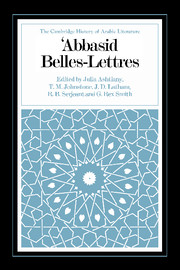Book contents
- Frontmatter
- The ʿAbbasid Caliphate: a historical introduction
- 1 Adab and the concept of belles-lettres
- 2 Shuʿūbiyyah in Arabic literature
- 3 Ibn al-Muqaffaʿ and early ʿAbbasid prose
- 4 Al-Jāḥiẓ
- 5 Al-Ṣaḥib Ibn ʿAbbād
- 6 Abū Ḥayyān al-Tawḥīdī
- 7 Al-Hamadhānī, al-Ḥarīrī and the maqāmāt genre
- 8 Fables and legends
- 9 ʿAbbasid poetry and its antecedents
- 10 Hunting poetry (ṭardiyjāt)
- 11 Political poetry
- 12 Love poetry (ghazal)
- 13 Wine poetry (khamriyyāt)
- 14 Mystical poetry
- 15 Ascetic poetry (zuhdiyyāt)
- 16 Bashshār b. Burd, Abū ʾl-ʿAtāhiyah and Abū Nuwās
- 17 Al-Mutanabbī
- 18 Abū Firās al-Ḥamdānī
- 19 Abū ʾl-ʿAlāʾ al-Maʿarrī
- 20 Literary criticism
- 21 Ibn al-Muʿtazz and Kitāb al-Badīʿ
- 22 Regional literature: Egypt
- 23 Regional literature: the Yemen
- Appendix: Table of metres
- Bibliography
- Index
5 - Al-Ṣaḥib Ibn ʿAbbād
Published online by Cambridge University Press: 28 May 2012
- Frontmatter
- The ʿAbbasid Caliphate: a historical introduction
- 1 Adab and the concept of belles-lettres
- 2 Shuʿūbiyyah in Arabic literature
- 3 Ibn al-Muqaffaʿ and early ʿAbbasid prose
- 4 Al-Jāḥiẓ
- 5 Al-Ṣaḥib Ibn ʿAbbād
- 6 Abū Ḥayyān al-Tawḥīdī
- 7 Al-Hamadhānī, al-Ḥarīrī and the maqāmāt genre
- 8 Fables and legends
- 9 ʿAbbasid poetry and its antecedents
- 10 Hunting poetry (ṭardiyjāt)
- 11 Political poetry
- 12 Love poetry (ghazal)
- 13 Wine poetry (khamriyyāt)
- 14 Mystical poetry
- 15 Ascetic poetry (zuhdiyyāt)
- 16 Bashshār b. Burd, Abū ʾl-ʿAtāhiyah and Abū Nuwās
- 17 Al-Mutanabbī
- 18 Abū Firās al-Ḥamdānī
- 19 Abū ʾl-ʿAlāʾ al-Maʿarrī
- 20 Literary criticism
- 21 Ibn al-Muʿtazz and Kitāb al-Badīʿ
- 22 Regional literature: Egypt
- 23 Regional literature: the Yemen
- Appendix: Table of metres
- Bibliography
- Index
Summary
One of the foremost prose-writers and poets of the fourth/tenth century, Ibn ʿAbbād was also an able politician and administrator and a great patron, a kātib who for more than eighteen years successfully held office as vizier to a branch of the Buwayhid family. Biographical sources are agreed upon his name (ism) and genealogy (onasab): Ismaāʿīl b. ʿAbbād b. al-ʿAbbās b. ʿAbbād b. Aḥmad b. Idrīs. They also agree on his agnomen (kunyah), Abū ʿl-Qāsim, which must have been given to him in childhood, since he had no son. Varying explanations are given of the honorific title (Jaqab) of al-Ṣāḥib usually prefixed to his name. Some sources say that the form of the title was originally ṣāḥib Ibn al-ʿAmīd, “the companion of Ibn al-ʿAmīd”, because it was Abū ʿl-Faḍl Ibn al-ʿAmīd, vizier to the Buwayhid amir Rukn al- Dawlah, who had trained him as a kātib. Others claim that the title in its full form was ṣāḥib Muʿayyid al-Dawlah, and that it was given in recognition of Ibn ʿAbbād's loyalty to the Buwayhid amir of that name. Whatever the true explanation, it was soon forgotten, and the title al-Ṣāḥib thereafter entered the repertory of Muslim honorifics. The zeal and efficiency with which Ibn ʿAbbād discharged his duties as vizier also earned him the more formal title of Kāfī ʿl-Kufāh, “the most competent of the competent”.
- Type
- Chapter
- Information
- Abbasid Belles Lettres , pp. 96 - 111Publisher: Cambridge University PressPrint publication year: 1990

